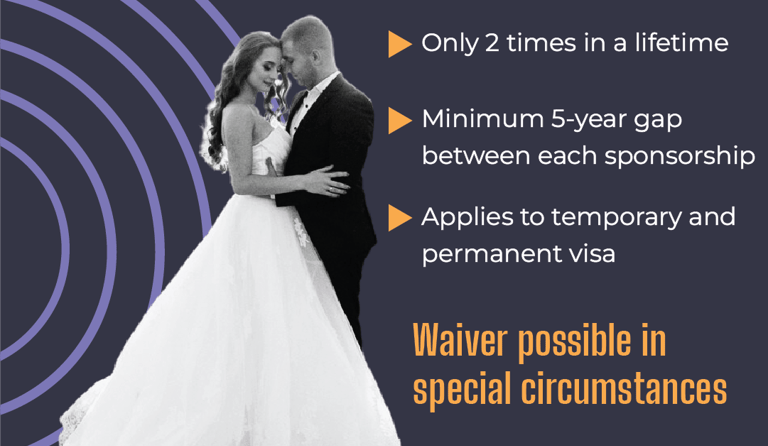Legal Limitations on Sponsorship for Partner and Prospective Marriage Visas in Australia
Thinking of sponsoring your partner or fiancé to come to Australia? Before you start, it’s crucial to understand the legal limitations on partner visa sponsorship—including the lifetime cap, 5-year rule, and possible exemptions. In this detailed guide, we explain what the law says, who’s affected, what exceptions exist (like having a child or past DV), and how to successfully request a waiver. Real-life scenarios, FAQs, and professional insights make this a must-read for anyone considering a partner or prospective marriage visa.
PARTNER VISA
4/24/20254 min read


Introduction
Thinking about sponsoring your partner or fiancé to join you in Australia? That’s a beautiful journey—but before you dive into the paperwork, there’s a critical rule you need to know: you can only sponsor a partner twice in your lifetime under Australian migration law. Plus, there needs to be a five-year break between each sponsorship. Surprised? Most people are.
Let’s unpack this together so you can move forward with confidence and clarity.
Overview of Partner and Prospective Marriage Visas
Australia offers a few different visa pathways for couples, each designed for different relationship types:
Subclass 820/801 (Onshore Partner Visa)
For couples already in Australia, offering a path to permanent residency.Subclass 309/100 (Offshore Partner Visa)
For those applying from overseas.Subclass 300 (Prospective Marriage Visa)
For fiancés planning to marry after arriving in Australia.
All of these fall under the same sponsorship limitation rules.
Lifetime Sponsorship Limit – What It Means
Here’s the big headline: You can only sponsor a partner twice in your life, and each sponsorship must be at least five years apart.
It doesn’t matter whether it was a marriage, de facto relationship, or engagement—each counts toward your sponsorship cap.
The Legal Basis Behind the Rule
This rule is based on Migration Regulation 1.20J and reflects the government’s aim to:
Prevent misuse of the migration system
Protect vulnerable applicants
Ensure genuine and long-term relationships
Exceptions to the Sponsorship Limitation Rule
Before you lose hope—there’s good news. Waivers are possible in certain cases.
Exception 1: Having a Child Together
If you and your partner have a child together, you may qualify for an exemption. You’ll need to prove:
The child is biologically or legally yours
You’re both actively involved in raising the child
Exception 2: Death of a Previous Partner
If your previously sponsored partner passed away, the Department may waive the rule based on compassionate grounds.
Exception 3: Relationship Breakdown or Abandonment
If the previous relationship ended due to abandonment or lack of support, you may qualify for an exemption by providing:
Personal statements
Evidence showing neglect or one-sided effort
Exception 4: Long-standing and Genuine Relationship
This is often overlooked. If your current relationship is:
Long-term (2+ years ideally)
Exclusive, committed, and genuine
You can request a waiver with strong supporting evidence of cohabitation and shared life.
Sponsorship Restrictions for Former Visa Holders
If you were once sponsored for a partner visa, you must wait five years from the date you applied, not from when the visa was granted, before you can sponsor someone else.
What If You Never Married or Entered Australia?
Even if your sponsored partner:
Never entered Australia, or
You broke up before marriage or arrival
It still counts as a sponsorship under the law. The visa approval alone is what matters—not the follow-through.
The Role of Domestic Violence in Sponsorship Records
If your previous relationship ended due to domestic violence, you may still be able to apply. However, that sponsorship may still count unless a special legal submission is accepted.
Due to the sensitivity of this area, it’s vital to seek professional advice early. You can start here: Millennium Migration
Importance of Legal Submissions and Evidence
Requesting an exemption isn’t just about writing a letter. You’ll need to prepare:
Statutory declarations
Evidence of relationship length, cohabitation, shared finances or assets
Statements on why previous relationships ended
A well-structured submission significantly improves your chances.
Common Mistakes and Misconceptions
“We never married, so it doesn’t count.” → It might.
“They never used the visa.” → Still counts.
“We broke up before the visa was granted.” → If approved, it still counts.
Tip: Always have your case assessed by a registered migration agent.
Real-Life Scenarios: What You Should Know
Case A – Sarah:
Sponsored her fiancé five years ago. They never married, and he never came to Australia. She still needs to wait or apply for an exemption.
Case B – Mark:
Was previously sponsored. The relationship ended due to domestic violence. After five years and with proper evidence, he successfully sponsored his new partner.
How to Seek Exemptions Successfully
Gather your relationship evidence (photos, joint leases, utility bills, birth certificate of children, etc.)
Prepare strong personal statements
Work with a migration expert to draft your legal submission
Be honest and consistent—credibility is key
Conclusion
These rules may seem tough, but they exist to protect people and preserve the integrity of the migration system. If you’re facing challenges with sponsorship limitations, know that legal pathways and exemptions do exist.
Your story is unique. So should be your approach. If you're unsure how your history impacts your eligibility, get it checked early and properly.
Need help navigating your options? Contact Sam Lotfollahi | Senior Registered Migration Consultant | MARN 0901704
📍 16+ Years of Proud Service
💬 Book a Consultation
FAQs
1. Can I sponsor my partner again if my first sponsorship was 6 years ago?
Yes, you can—provided it’s been over five years since your last sponsorship and you haven’t already sponsored two people in total.
2. What if I sponsored someone but they never used the visa?
Unfortunately, it still counts under the law. The approval of the visa triggers the limitation, not whether they entered Australia.
3. Does a de facto relationship count the same as a marriage?
Yes, it does. Both are considered partner sponsorships under Australian migration law.
4. What if I sponsored my ex and they were abusive?
You may be eligible for an exemption, especially if you can show evidence of domestic violence or abandonment.
5. Who decides if my exemption is approved?
The Department of Home Affairs reviews each case individually. A professionally prepared legal submission can significantly boost your chances.
